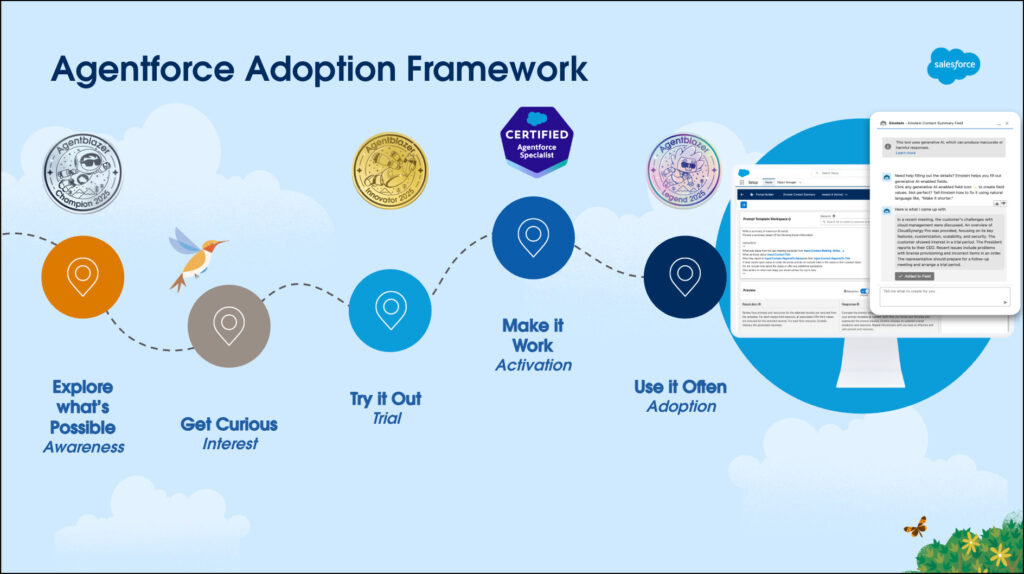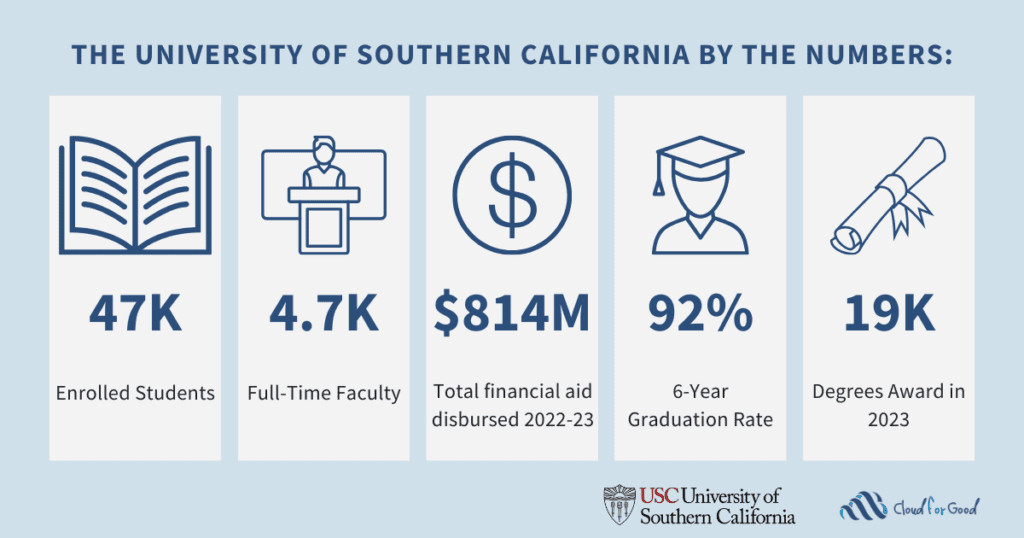There’s been a lot of talk about the Agentforce development lifecycle. As admins, we know that you can’t just jump into building without an implementation plan to guide users to adopt new technology. So how do we get to the development lifecycle and create a partnership between our users, customers, and agents? We build a solid foundation in adoption.
Meet the Agentforce Adoption Framework
Like any emerging technology, learning about generative artificial intelligence (AI) and implementing Agentforce is an exciting challenge that comes with both “aha!” moments and pain points. On the Admin Relations Team, we want to make sure you’re prepared for a successful implementation—from first exposure to full adoption.
If you’re just beginning your journey with Agentforce, we want to give you a starting point. If you’re already learning and building agents, we want to provide insight into what comes next on your road to successful adoption and building out Agentforce across the enterprise. And wherever you are on your journey, we want to provide helpful resources and actions to take to further your education. Think of the Adoption Framework as your path to becoming confident with this new technology.
Here are the five stages we’ve identified as part of your exciting Agentforce adoption journey.
1. Explore what’s Possible
Before rolling out a new technology initiative, we need to get educated and exposed to the technology. As admins we’re the product owners of Salesforce and will naturally be seen as (and become) the subject matter experts in Agentforce (or any application we’re implementing). Before generating interest internally, we need to gain exposure through Trailhead and different enablement events to get that initial hands-on know-how.
In this phase, you might feel intrigued by Agentforce, hoping to answer some questions and address pain points, such as:
- Being unsure of how the technology works
- Being unable to picture use cases for your own business needs
Some actions admins can take to Explore what’s Possible include:
- Getting hands-on in Trailhead
- Becoming an Agentblazer Champion
- Attending in-person events such as Agentforce World Tour, TDX, and Dreamforce
- Participating in Agentforce NOW virtual enablement events
If this sounds like where you are in your Agentforce journey, take a look at these resources.
- Salesforce Admins Blog: Introduction to Agentforce for Salesforce Admins
- Salesforce Admins Blog: How Admins Drive Innovation With Core Responsibilities in the Agentforce Era
- Salesforce Admins Podcast: 2025 Roadmap for Salesforce Admins: AI, Agentforce, and Emerging Trends
2. Get Curious
Once you have foundational skills and an understanding of how Agentforce can work for your organization, it’s time to build interest and gain stakeholder buy-in. This is the stage where you put together a demo for leadership and lead whiteboard sessions to brainstorm ideas for your organization. This is also a great time to talk to your Salesforce Account Executive to get a sense of budgeting.
In this phase, you might feel inquisitive and inspired to bring Agentforce to your own personal use case(s). Pain points might include:
- Feeling unsure of how to host a stakeholder presentation/demo to gain buy-in
- Determining metrics you want to report on
Some actions admins can take to Get Curious include:
- Delivering a demo to stakeholders
- Whiteboarding agentic needs specific to your business and industry
- Creating a journey map to support implementation plans
- Writing user stories and defining acceptance criteria
If this sounds like where you are in your Agentforce journey, take a look at these resources.
- YouTube video: TDX 25 | Demo to Deployment: Engaging Stakeholders with Agentforce
- Salesforce Admins Podcast: 5 Steps for Admins to Get Agentforce Ready
- Salesforce Admins Blog: AI and Agentforce: Governance Strategies for Your First Project
3. Try it Out
After gaining buy-in with a general Agentforce demo, it’s time to take the use cases you identified and get building using Salesforce Foundations or a Developer Edition. This is the most fun part for us, because it’s where our admin skills intersect with new technology and we get to create optimal experiences for our users and customers.
In this phase, you might feel eager to bring Agentforce to life, and you might encounter a couple pain points that you are well equipped to deal with as an admin, including:
- AI requires clean data. You might identify some data cleanliness issues that you need to tackle.
- Your agents might require lots of trial, finessing, and custom actions to ensure they’re reliable and you’re getting desired results.
Some actions admins can take to Try it Out include:
- Building an Employee agent (internal facing)
- Using Salesforce Foundations or a Developer Edition
- Becoming an Agentblazer Innovator
If this sounds like where you are in your Agentforce journey, take a look at these resources.
- YouTube video: Use Case: Client Preparation Agent | Agentforce Decoded
- Salesforce Admins Blog: Community-Crafted Agentforce Use Cases To Customize for Your Org
- Salesforce Admins Blog: Explore the Coral Cloud Resorts Sample App: Your Path to Agentforce Success
4. Make it Work
After trying out Agentforce with your own use cases, you’ll take your findings back to your stakeholders to make sure you’re in alignment. After any changes or updates, you’ll be ready to head into activation to turn on Agentforce and deploy your agents to production. At this stage, you should clearly see AI and Agentforce as part of your admin responsibilities, role, and future career plans.
In this phase, you hopefully feel satisfied with your career growth and your ability to actualize Agentforce at your organization. Some new pain points to tackle might include:
- Needing support to embed your agent in the flow of work; this might be in Salesforce Experience Cloud, on an external facing site, in Slack, or in mobile.
- Refining the metrics you want to get out of your agents and reporting back to stakeholders to share your progress
Some actions admins can take to Make it Work include:
- Progressing from an Employee agent to a use case for an external or customer facing agent
- Getting certified as an Agentforce Specialist
- Adding further AI education into your career plan
- Turning on and implementing Agentforce in production
If this sounds like where you are in your Agentforce journey, take a look at these resources.
- Salesforce Admins Blog: Best Practices for Building Secure Agentforce Service Agents
- Salesforce Admins Blog: Prepare for the Agentforce Specialist Exam
5. Use it Often
The final stage in the adoption journey is true adoption. You’ve brought Agentforce to your organization. Now, you’re transitioning into a regular cadence of using the Agentforce Development lifecycle as you deploy agents across the enterprise, with multiple agents working together.
In this phase, you deserve to feel proud of your accomplishments and might feel excited for the future of Agentforce at your organization. The challenges you experience might be more around user adoption and future proofing and could include:
- Creating strong training and adoption support processes
- Feeling unsure of how to expand to further agentic use cases and have agents working together
- Determining next steps for Agentforce development at your organization
Some actions admins can take to Use it Often include:
- Bringing your analytics plan to life
- Orchestrating multiple agents working together
- Supporting your users and creating helpful documentation
- Becoming an Agentblazer Legend (coming soon)
If this sounds like where you are in your Agentforce journey, take a look at these resources.
- Salesforce Admins Blog: Agentblazers Share Their Best Tips for Building With Agentforce
- Salesforce Admins Podcast: AI-Powered Dynamic Layouts for Salesforce Admins
- YouTube video: Extend Your Slack Automation With Agentforce | Agentforce Decoded
What’s next?
We want to give you a sneak peek on what we’ve been working on! We’ll continue sharing more content to guide you through each stage of your Agentforce adoption journey. Stay tuned for more content like this!
I want to give a big thanks to the Awesome Admins and MVPs who provided feedback on this framework to share their thoughts, stories, “aha!” moments, and challenges.
The post Your 5-Step Guide to Successful Agentforce Adoption appeared first on Salesforce Admins.




